The GIGABYTE MZ31-AR0 Motherboard Review: EPYC with Dual 10G
by Gavin Bonshor on March 25, 2020 1:15 PM ESTVisual Inspection
The GIGABYTE MZ31-AR0 is an E-ATX motherboard designed for workstation and server environments. Rev 1.x is compatible with AMD's EPYC 7001 family of processors, and features a rotated LGA 4094 CPU socket which makes it suitable for 1U chassis types for airflow, although users can use it in with compatible chassis that support E-ATX form factors. It uses GIGABYTE's recognizable blue PCB, with black PCIe slots, white power inputs, and black and blue alternating memory slots.
Using an E-ATX sized PCB, this has allowed GIGABYTE to include plenty of expansion support. In the bottom left-hand corner there are seven PCIe expansions slots including five full-length PCIe 3.0 x16 slots, one full-length PCIe 3.0 x8 slot, and two half-length PCIe 3.0 x8 slots. The configuration used with all slots combined is x8/x16/x8/x16/x16/x8/x16, with GIGABYTE opting for single slot spacing between each slot.
Providing power to the board is a single 24-pin 12 V ATX power input, while the for CPU power is a pair of 8-pin 12 V ATX power inputs. Located around the board is plenty of headers and I/O. For cooling the MZ31-AR0 has two dedicated 4-pin CPU fan headers and five for chassis fans. A front panel header allows users to connect up power, HDD LED indicator and reset buttons for a chassis, while the board also includes a single TPM and COM2 header. For use in 1U or compatible server blades, the board includes a single HDD backplane header, a PMBus, and IPMB header, with a clear CMOS and BIOS recovery jumper.
Due to the E-ATX sized frame, GIGABYTE includes a total of sixteen memory slots which has support for up to 2 TB of LRDIMM and RDIMM ECC memory modules (Ian: I tried 2TB, it worked!). The GIGABYTE MZ31-AR0 has support for up to DDR4-2666 memory when used in a 1 DIMM per channel configuration, but DDR4-2400 and DDR4-2133 are also supported with this model. Due to the location of the PCIe 3.0 slots and the memory slots, there may be some incompatibility with larger expansion cards as our testbed NVIDIA GTX 1080 protrudes over the right-hand side memory slots. The only two slots not restricted are the two bottom PCIe 3.0 slots (x8/x16).
The board is well-equipped on storage with four SlimSAS ports with each port offering support for up to four SATA devices and drives. This gives a total of sixteen SATA slots, with assistance from a single PCIe 3.0 x4 M.2 slot which supports up to M.2 2280 form factor drives.
Located in the top left-hand section near to the rear panel I/O is the Aspeed AST2500 remote management controller which is assisted by a rear panel Gigabit Ethernet port which allows BMC control from a network, and a single D-sub video output. Just above this is a silver cross-cross heatsink which keeps the Broadcom BCM57810S Ethernet controller cool. The Broadcom BCM 57810S provides two SPF+ 10 G Ethernet ports on the rear panel, although the ports do support Gigabit networks too.
As the GIGABYTE MZ31-AR0 is designed for workstation and server systems, the power delivery equipped is modest but effective in delivering enough power to support up to 32-core AMD EPYC processors. Its power delivery is using a simple 6-phase setup with no heatsink used, which means cooling it will rely on having adequate passive airflow in whichever chassis it is installed into.
On the rear panel is little in the way of USB support with two USB 3.1 G1 Type-A, and two USB 2.0 ports. This required us to use a USB hub to install our testbed operating system (Windows 10 1909) with a keyboard and mouse plugged in; shrewd users can do so while just using a keyboard or mouse. Also present is an ID button with an LED, one Gigabit Ethernet port for the BMC, two SFP+ 10 G Ethernet ports powered by a Broadcom BCM 57810S Ethernet controller. A solitary serial port and D-sub video output powered by the Aspeed AST2500 remote management controller finish off a basic, but effective rear I/O.
What's in The Box
Included in the retail packaging is two SlimSAS to SATA cables which gives users the ability to install up to eight SATA devices out of the box. Also present is an I/O shield and a quick start guide. When bought in bulk (10 units), each box comes with just an I/O shield.
- 2 x SlimSAS cables (four SATA per cable)
- Rear Panel I/O shield
- Quick Start guide


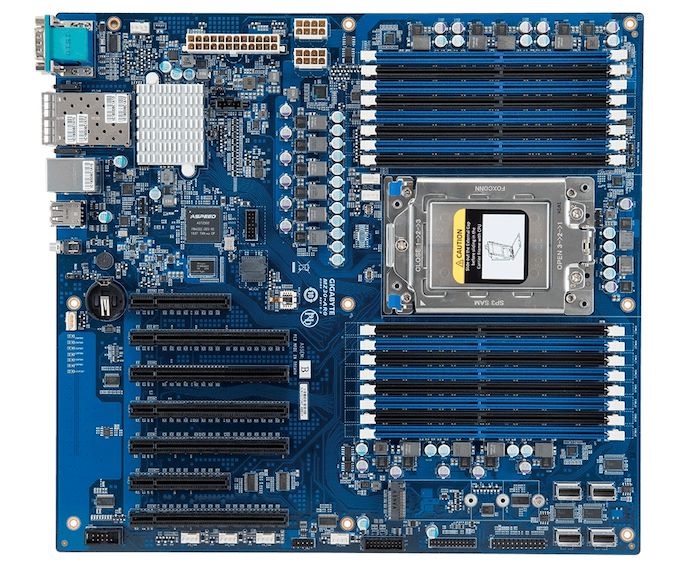
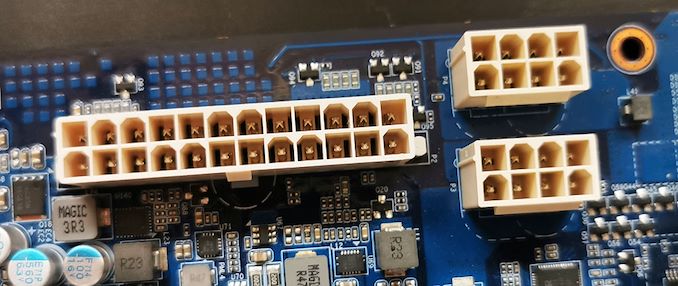
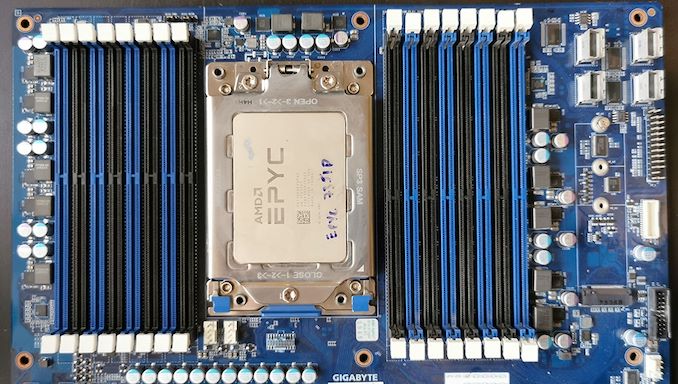
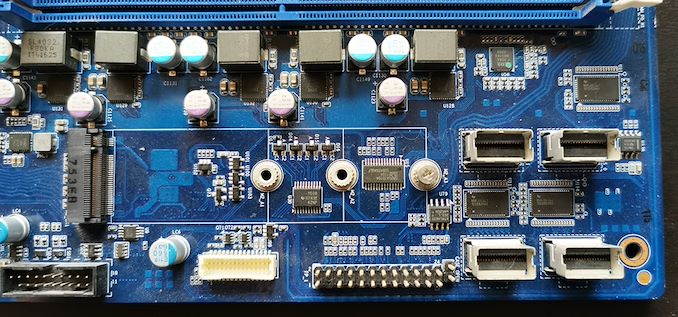
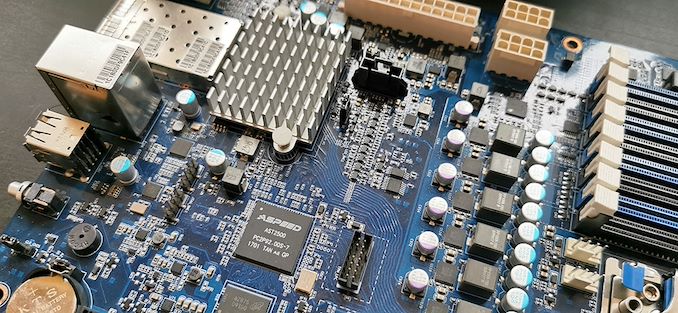
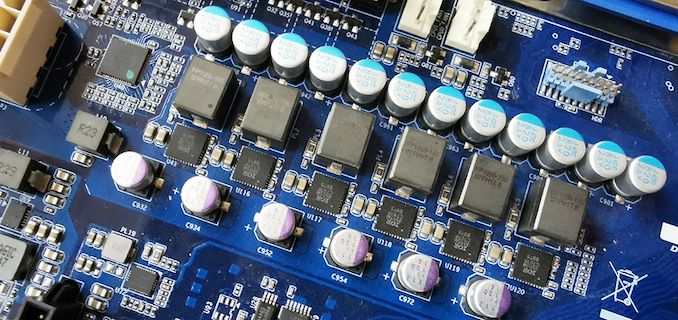










37 Comments
View All Comments
sonny73n - Wednesday, March 25, 2020 - link
Wow, two Gigabyte motherboards reviews in a week!?I have to find something else to read.
demu - Wednesday, March 25, 2020 - link
You should also test ASRock Rack ROMED8-2T.It supports 7x PCIe Gen4 x16 expansion slots, 2TB of DDR4 3200 (with 256GB LRDIMMs), 2x10GB ethernet ports etc.
And the memory slots don't block long PCIe cards.
https://www.asrockrack.com/general/productdetail.a...
p1esk - Wednesday, March 25, 2020 - link
Now this is a board I want for my next 4xGPU deep learning workstation. Though EPYC cpus suck frequency wise (when compared to equivalent core count TRs). Basically it comes down to whether I want a good memory bandwidth (8 channels vs 4 channels), and whether I want the full 16 lanes per GPU for all four GPUs. Serious trade-off. Why can't they put a pcie switch into a TR board (I'm talking about ASRock TRX40 Creator)?Deicidium369 - Sunday, April 12, 2020 - link
LOL that's cute you think there is so much traffic to those GPUs that you not only need PCIe4 - but 16 lanes per. Pretty sure your "4xGPU deep learning workstation" is a theoretical purchase, and will not materialize in any way shape or form. You could put those on 8 lane PCIe3 and get the same results. Moar Corez Moar Lanez No Cluez. Keep dreamingSlash3 - Wednesday, March 25, 2020 - link
It's not yet available at retail (soon™), but it should be an absolute beast of a board.Ktracho - Friday, March 27, 2020 - link
This article doesn't sufficiently highlight the impact of the memory slots interfering with the PCIe slots. This severely limits the use cases for this motherboard. Someone mentioned using this board in a storage server, but I doubt such a system needs the bandwidth that Gen. 4 slots provide. I think Gigabyte would have been able to increase their market by going with a design similar to ASRock's, which has 1 DIMM slot per memory channel. This would have allowed the use of multiple accelerator boards, which can make use of the bandwidth the Gen. 4 slots provide. I get the impression that Gigabyte's designs are geared toward specific customers.On the positive side, as far as I can tell, this board has been the only Gen. 4 motherboard on the market that supports EPYC CPUs, which to me is surprising given how long it's been since EPYC CPUs were announced.
phoenix_rizzen - Saturday, March 28, 2020 - link
There are no Gen 4 slots on this motherboard. It's all PCIe 3.Ktracho - Monday, March 30, 2020 - link
My bad. I got confused with the MZ32-AR0, with which I have personal experience. It looks very similar, but it has PCIe Gen. 4 slots, all of which, except for one, are also obstructed by DIMM slots.paulinus - Saturday, March 28, 2020 - link
Omg, *almost* perfect motherboard for my upgrade.Is there anything similar, but with sTR3/threadripper?
Seriously, with all that bandwith, noone has truly workstation board, without wifi, but with 1-2 10g ports integrated, and more than 3 usable slots...
I need tr board, with 10g, and layout supporting 3slot gpu (7slots or lets say, in xlatx manner, last slot with 16lanes), two pcie ssd (intel Pseries, not m2), one slot with bifurbication for 2-4 m2 slots card, maybe sound card, and one free slot, or even two, for second (2slot) gpu, 25gb+ lan, or another monster ssd.
I can get it for intel cpus easily, but i *really* want to leave that swamp for amd
ballsystemlord - Wednesday, March 25, 2020 - link
@Gavin will a threadripper CPU work in an EPYC motherboard?I'm just curious. I did search online. Thanks!